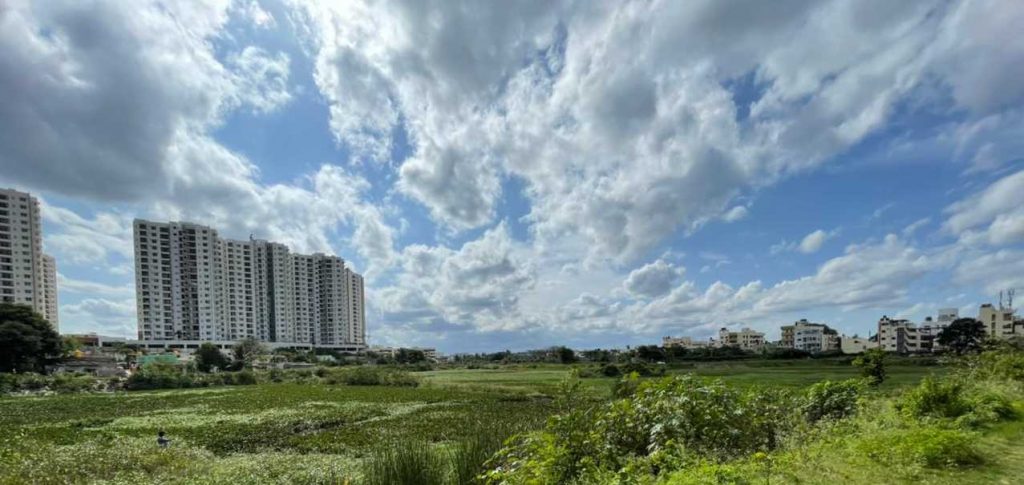Despite order on restoration, lakes continue to be threatened
By Bhargavi S Rao

In its final order in a PIL filed by the Environment Support Group advancing the cause of wise use and appropriate protection and rehabilitation of lakes, the Karnataka High Court had, on April 11, 2012, directed an end to the policy of privatisation of lakes. It supported a participatory scheme to ensure protection and rehabilitation of lakes and canal networks, not only in Bengaluru but across Karnataka.
Basing its order on two reports prepared on the request of the court by Justice N K Patil, then sitting judge of the High Court and Chairman of Karnataka State Legal Services Authority (KSLSA), it said the plan was to restore lakes as rich biodiversity wetlands advancing water and livelihood security – within two years of the order.
The Justice Patil Committee’s key messages were to decentralise lake management by establishing District Lake Protection Committees which would guide local communities to protect and rehabilitate lakes and raja kaluves, and also attend to disputes that arose. An appellate Apex Committee headed by the State Revenue Secretary with assistance from Member-Secretary of KSLSA was also carved out as a quasi-judicial appellate body to attend to any disputes. The idea was to make lake management accessible to the public anywhere in the state.
Nearly a decade later, lakes continue to be threatened. There is widespread neglect of lakes across the state and this is resulting in water, livelihood and ecological crises. Responding to High Court directives, the Karnataka Legislature had introduced the Karnataka Tank Conservation and Development Authority the (KTCDA) Act in 2014, which was comprehensively amended in 2018. This also resulted in the establishment of the Authority and scrapping of the Lake Development Authority (LDA).
Following the Karnataka High Court direction in 2012, a few lakes across Bengaluru started appearing bluer, cleaner and greener. A ‘one size fits all’ approach involving creation of a walking path all around, planting saplings, construction of islands and other ornate refurbishments, has been the model for lake ‘development’.
With private sector support through the Corporate Social Responsibility (CSR) route, Lakeathon, Wake the lake, Adopt a lake, etc, have been the popular drives, sometimes with community participation. With little or no attention being paid to the ecological vitality or livelihood support, and predominantly catering to the imaginations of a few, have turned lakes into soup bowls.
The structure, size and form of lakes govern many processes such as sedimentation, diffusion, mixing, inflows and outflows, that are critical to the life of a lake. These in turn determine the abiotic factors such as pH, suspended particulate matter, concentrations of nutrients, biological oxygen demand (BOD) and dissolved oxygen.
The primary and secondary production systems and other biotic factors depend on these abiotic parameters. When this dynamic is disturbed at any stage, the lake ceases to live.
Lakes have been built across south India over thousands of years and typically comprise of a large shallow zone, with an extended foreshore, and a deep water zone at the bund. This improves the biodiversity potential of the lake substantially as over 60% of the aquatic flora and fauna are in the shallows.
Such a design helps maintain the lake easily, in removing silt which can be used as manure. These lakes were never meant to be perennial – when they went dry, they would be grazing pastures.
Lakes ‘rehabilitated’ by the BBMP, however, have water through the year. This is because of sewage inflow and release of treated water from sewage treatment plants.
As a result, lakes which supported migratory birds from as far as Siberia and Mongolia, have now become centres for exercise, socialising and recreation. Studies by Birdwatchers Field Club of Bengaluru reveal that there is a widespread fall in species diversity and in absolute numbers of migratory waterfowl visiting the city, indicative of large-scale biodiversity erosion.
Traditional lake users such as fisher folk, lotus harvesters, grass collectors, have all been pushed to the margins of their livelihoods. Amongst all the efforts, the forest department has perhaps been the only agency which has sensitively rehabilitated lakes by turning them into functional ecosystems.
Like old wine in a new bottle, the KTCDA has been approving the handing over of lakes to corporates, exactly like the way LDA leased lakes back in 2012. Churning out MoUs based on Detailed Project Reports lacking application of science and social praxis and delays in implementing earlier orders have been brought to the attention of the High court.
Under the Public Trust Doctrine, lakes are common property resources. Those who are at the intersection of power, influence and finance have an advantage over those who protected and used the lakes.
Mostly, it is about monopolising control over these commons, dodging the law, the order of the court and thereby of capturing the few natural living resource-landscapes of cities.
Besides taking control, which means they get to decide who can use them to fish, harvest lilies or watch birds, they also get to decide many administrative issues relating to the use and upkeep of lakes – aspects that were under the control of local communities and local government.
This obviously means preserving biodiversity for posterity and long-term water security will be in the hands of those with power and influence, and access to agency – the elite. Access to and availability of common property resources for the poor will not only decline, that right may go on to be annihilated.
Efforts by state agencies seem to miss the point that public expenditure in the model of ‘lake development’ now pursued will only result in public money being poured down the drain, with no benefit in terms of protection of lake, their biodiversity and their capacity to support livelihoods, for now and into posterity.
Published in : Deccan Herald

